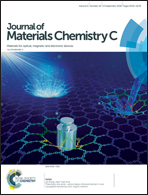Actuating thermo- and photo-responsive tubes from liquid crystalline elastomers†
Abstract
Large (many mm long) closed tubes from liquid crystalline (LC)-elastomers can be prepared in a microfluidic setup by photopolymerization of an LC-monomer mixture. In these tubes, the director of the LC-phase is oriented parallel to their long axes as proven by X-ray measurements, thus leading to shortening at the transition to the isotropic phase while their walls become thicker simultaneously. The process of tube preparation relies on an appropriate choice of 3 immiscible phases in the microfluidic setup (continuous, LC-monomer and inner phase) as well as their interfacial tensions. Water can be used as the inner phase in combination with a selective detergent (an amphiphilic block copolymer from PNIPAM and the LC-polymer) to reduce the LC/water surface tension. In this way, long actuating (up to 50%) tubes can be prepared either from a thermotropic LC-elastomer or from an azo-containing LC-elastomer with the latter being both thermo- and photo-responsive. By irradiation of individual tubes consisting of the azo-system with white (trans–cis) or red light (cis–trans), actuations of up to 29% can be achieved. The contraction (shortening) of the tubes thereby requires about 10 seconds, while the photochemical reisomerization needs about 230 seconds. This sets the time frame for the tubes’ photochemical actuation.



 Please wait while we load your content...
Please wait while we load your content...